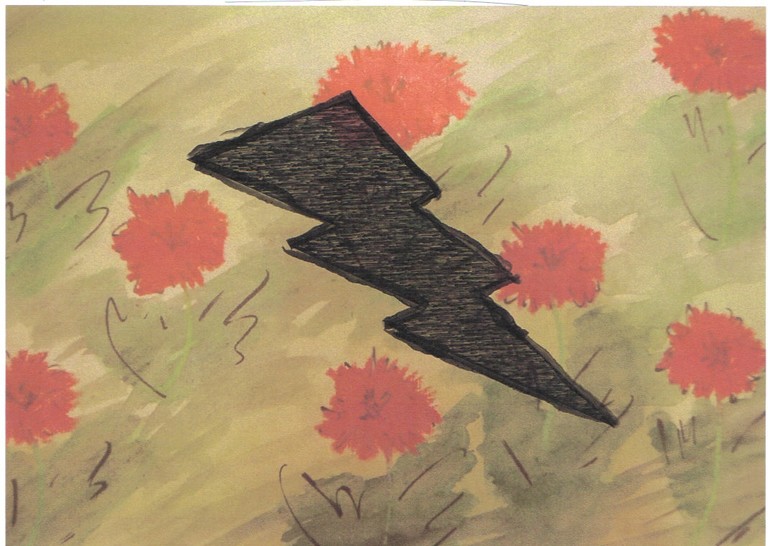Robert O. Fisch, Light from the Yellow Star
Text und Illustrationen wurden von Frau Mag. Irene Fochler-Loos in ihrem Unterricht nach dem Buch von Robert O. Fisch: LIGHT FROM THE YELLOW STAR. A Lesson of Love from the Holocaust gestaltet
Robert O. Fisch hat als ungarischer Jude den Terror der Konzentrationslager überlebt. Er kehrte nach dem Krieg nach Ungarn zurück und flüchtete 1956 vor den Sowjets in die USA. Hinweise zum Buch von: Nadja Danglmaier/Christian Gmeiner/Manfred Wirtitsch: Anregungen für den Unterricht. Methodisch-didaktisches Material zu - download
Text and artwork result from a lesson of Irene Fochler-Loos and are based on the book of Robert O. Fisch (Schulzentrum Herbststraße, Art Department, Vienna, Austria)
STUDENTS´ REFLECTIONS TO PICTURES OF HOLOCAUST SURVIVORS
THE NEWS (TRAIN PICTURE) reflections by Matthias Rieser
The picture shows one of the trains that are going to the concentration camps. The train is painted crimson red like blood. Even the smoke from the locomotive is coloured crimson.
There are hands reaching out from the train like they are reaching for help in despair.
I feel like a spectator of the despair of these victims. The picture makes me feel the fear that these people experienced when they saw how their family and friends were carried off in one of these wagons. The picture shows how the people were loaded like cattle. How could people ignore such suffering when they were directly confronted with it?
When I look at the picture I see that it tries to convey a message: such atrocities must never happen again!!
NADINE KRAUSSLER “Dawn in the darkness”
The picture shows the hopelessness of people who were forced in the furnace room. It was dark and they were scared to death and cried. My picture shows the light in the darkness and the small hope that a miracle will happen and they will be saved.
FLORENTINE KLEYHONS “Oh God, in my sorrow I turn to Thee.”
Two questions occurred to me when I read the text. First of all the story about the woman who tried to help the prisoners by giving them apples. I´m pretty sure she didn´t know that she had to pay with her life for her good deed. And I ask myself what I would have done in her situation knowing how dangerous this was?
The second question is why the behaviour of people always changes when they are acting as a group (compared to what they would do if they were alone and would decide by themselves).
Not only back then but also today.
TERESA LAMERS “Dawn in darkness”
The picture “Dawn in darkness” is a symbol of hope after war. At first sight you see a big black space. But then you recognize a door which is opened. The colourful circle which gets lighter in the middle looks like a rising sun. The people who watch this picture think about what could be in the background. Is it something scary and terrible, is it death?
But the door could also symbolize the end of war and the liberation of the prisoners in the concentration camps. The door opens to the surviving Jews and give way to a new life.
Behind the black walls you might expect a colourful world. But there could also be the picture of the horrible killing of Jewish people.
CORDULA WILDGANS
WWII is one of the most cruel events in the world history. This is expressed by the black surface of the painting. The lower part of the picture is more black than the top where you can recognize circles. The circular lines stand for the friendly and helpful people who risked their own life to save others.
It is an impressive picture that inspires me to think of the Holocaust and all the suffering it brought along.
DENISE LAMP “Dawn in darkness”
The years between 1939 and 1945 are a time which is marked by cruel memories. Millions of people lost their life. And for which reason? Only for the pursuit of power of one individual.
The second world war was one of the most horrible and discriminating massacres triggered by Adolf Hitler who was born in Austria but lived and fought for the idea of a German Empire.
More than 60 million of innocent people got killed in Germany, Austria, Russia, Italy and many other countries. All in all it was a useless attempt based on Hitler´s vision of a pure German race.
Especially Jews, disabled and weak people were arrested, tortured or killed in concentration camps. That´s exactly what the picture is showing us. The rescue of some of these victims by the Americans is presented by the light.
A door opens in a black and empty world. But behind it, the light of hope is shining out of the darkness.
LEO KITTER “Oh, God, in my sorrow I turn to Thee.”
In the middle of the picture there is an apple. The bottom of the picture is dark but it gets lighter towards the top. In the dark parts there are skinny hands that are reaching up to the apple. At the top there is a bigger hand which looks like it would offer the apple to the thin fingers. I think the picture says that even in the greatest sorrow there are helping hands.
The picture also says that richer, luckier people should help the poor ones and that it is important to be there for each other.
EISENBAUER MARIA “Oh God, in my sorrow I turn to Thee”
The picture shows the hunger, pain and desperation of the prisoners. But it also conveys their hope and their will to survive. The author of the accompanying text is admirable because he is still optimistic although he saw so much pain and blood and killing. He still believes in god, so he must be very confident, strong-minded and trusting in the plan of God
PHILIPP HAGENBICHLER “The songs of the sanctuaries turned into screams.”
I see in this picture an altar in a synagogue where usually services are held.
But in this synagogue nobody is singing. People who had such terrible experiences can only cry and shout out for help. I can recognize two stones that look like the stones bearing the ten commandments. But it only quotes one commandment: “Do not kill!” You can see hands that are stretching out for help. Even the flames have the shape of hands and complete a picture of despair and horror.
Information: http://www.yellowstarfoundation.org/index.htm
Zuordnung
- Region/Bundesland
- Niederösterreich












